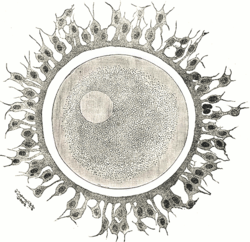The zona pellucida (Latin meaning "transparent zone") is the specialized area surrounding mammalian oocytes (eggs). It is also known as an egg coat. The zona pellucida is essential for oocyte growth and fertilization.
| Zona pellucida | |
|---|---|

Human ovum: The zona pellucida is seen as a thick clear girdle surrounded by the cells of the corona radiata.
| |
| Identifiers | |
| MeSH | D015044 |
| FMA | 18674 |
| Anatomical terminology | |
The zona pellucida is an extracellular matrix that surrounds the plasma membrane of the egg cell. It helps protect the egg, and has an essential role in fertilization by sperm. It is surrounded by the corona radiata. The corona is composed of cells that care for the egg when it is emitted from the ovary.[1]
The zona pellucida is a translucent matrix of cross-linked glycoprotein filaments that surrounds the mammalian oocyte and is 6.5–20 μm thick depending on the species. Its formation, which depends on a conserved zona pellucida-like (ZP) module that mediates the polymerization of egg coat components,[2] is critical to successful fertilization.[3] In non-mammals, it is called the vitelline membrane or vitelline envelope.[4]
The thick membrane of the zona pellucida functions to only allow species-specific fertilization; to prevent polyspermy, and enable the acrosome reaction for the successful adhesion and penetration by the sperm cell. It also allows correct embryo development and size. The major glycoproteins of the egg coat responsible, are known as sperm-binding proteins.[5]
The zona pellucida binds spermatozoa, and is required to initiate the acrosome reaction. In mice, the zona glycoprotein (ZP3) is responsible for sperm binding, adhering to proteins on the sperm plasma membrane. During the acrosome reaction, a sperm cell releases the DNA contained in the acrosomal vesicle into the egg. In other species, the process is slightly different and more complicated. Several more zona proteins have been identified.[6][7]
The four major sperm-binding proteins, or sperm-receptors, are ZP1, ZP2, ZP3, and ZP4. They bind to capacitated spermatozoa and induce the acrosome reaction. Successful fertilization depends on the ability of sperm to penetrate the extracellular matrix of the zona pellucida that surrounds the egg.[citation needed] In the mouse:
In humans, five days after fertilization, the blastocyst performs zona hatching; the zona pellucida degenerates and decomposes, to be replaced by the underlying layer of trophoblastic cells.[citation needed]
ZP module-containing glycoproteins ZP1, ZP2, ZP3 and ZP4 are targets for immunocontraception in mammals.[citation needed]
In non-mammals, the zona pellucida is called the vitelline membrane or envelope, and the vitelline envelopeininsects, and plays an important role in preventing cross-breeding of different species, especially in species such as fish that fertilize outside of the body.[citation needed]
The zona pellucida is commonly used to control wildlife population problems by immunocontraception. When the zona pellucida of one animal species is injected into the bloodstream of another, it results in sterility of the second species due to immune response. This effect can be temporary or permanent, depending on the method used. In New Jersey, immunocontraception using porcine zona pellucida has been trialled for the control of deer.[8]